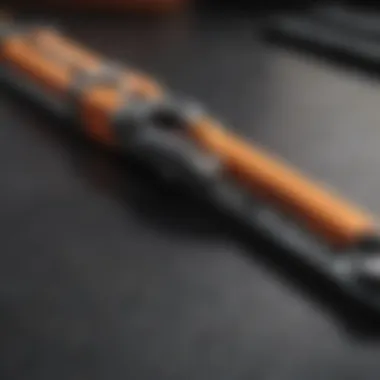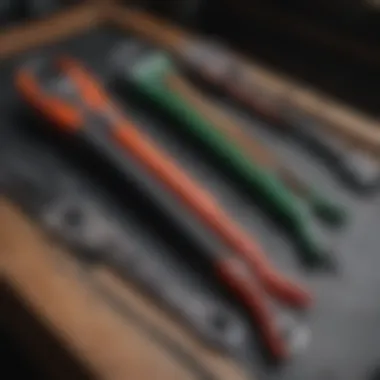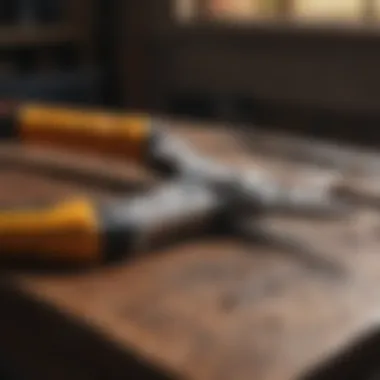Comprehensive Guide to Choosing the Best Bolt Cutters


Overview of Topic
When it comes to home improvement projects, having the right tools can make a world of difference. Among these, bolt cutters stand out as an essential tool in tackling various tasks, be it for security measures, DIY projects, or general maintenance. Whether you need to cut through chains, padlocks, or wire fencing, understanding the nuances of bolt cutters can vastly improve your efficiency and effectiveness.
The importance of this topic cannot be overstated. Homeowners often overlook the significance of selecting the appropriate cutting tools, leading to frustration and inefficiencies. A good bolt cutter enables anyone, be it seasoned DIYer or a novice, to execute tasks with precision and ease. This guide aims to shed light on the features and considerations surrounding bolt cutters, ensuring that you make informed decisions as you navigate the world of home improvement.
Common Challenges and Solutions
Homeowners frequently encounter challenges when it comes to cutting heavy or thick materials. These issues may arise from not having the correct tool or the right technique. Here are some common challenges along with practical solutions:
- Inadequate Tool Size: Many may find that their bolt cutters are either too short or too long for the task at hand.
Solution: Understanding the size specifications is critical. It’s important to assess the material thickness and choose a cutter that fits the job comfortably. - Poor Quality Materials: Some bolt cutters may bend or break, especially if they're made from subpar steel.
Solution: Invest in bolt cutters made from high-quality materials and brands known for durability. You'll find that it pays off in the long run. - Wrong Cutting Technique: Using the wrong angle or pressure can cause inefficiency or even damage to the tool.
Solution: Practice proper cutting techniques and read the instruction manuals that come with the tools. Proper usage ensures not just the longevity of the tool, but also the safety of the user.
Product Recommendations
When it comes to selecting top brands in the bolt cutter realm, certain products consistently rise to the top. Let’s take a look at some reliable names that consistently deliver quality:
- Klein Tools 63135: Known for its toughness, this model features high-quality steel jaws that provide excellent cutting power.
- Neiko 02037A: This is a versatile choice with a unique design ideal for both home use and professional applications.
- Olympia Tools 39-114: If you're looking for something more affordable, this model doesn’t compromise on performance while remaining budget-friendly.
Each of these options comes with benefits such as enhanced grip, reduced hand fatigue, and substantial cutting force, making them suitable for various materials.
Step-by-Step Guides
To ensure you make the most out of your bolt cutters, here’s a simple step-by-step guide:
- Choose the Right Bolt Cutter: Consider factors like size, handle length, and material type based on your specific cutting needs.
- Inspect Your Material: Identify the thickness and type of material to ensure compatibility with your selected bolt cutter.
- Prepare the Area: Clear the work area of any obstacles. Ensure you have good lighting and a stable surface.
- Set Up the Cut: Position the bolt cutter around the target area of the material. Make sure you have a secure grip on the handles.
- Apply Pressure Evenly: Squeeze the handles together, making sure to apply steady pressure until the material is cut through.
- Clean and Maintain: After use, clean your tool and inspect it for damage. Regular maintenance helps prolong the life of your bolt cutter.
Remember: Safety first! Always wear safety goggles and gloves to protect against any shards or debris that may result from cutting.
Preface to Bolt Cutters
Bolt cutters are indispensable tools that find their place in a variety of contexts, from residential settings to heavy-duty industrial applications. Understanding what these tools are and their purpose is paramount in ensuring one makes an informed choice. They are designed primarily to cut through chains, padlocks, wire mesh, and even some hard materials, which makes them quite versatile.
When it comes to home improvement or maintaining safety, owning a reliable set of bolt cutters can be as crucial as a trusty hammer or a reliable drill. For house owners and those occasionally taking on DIY projects, a bolt cutter can remove stubborn locks or dismantle unwanted fences without the hassle of calling a professional. In today’s fast-paced world, convenience is key, and the right tools can save both time and effort.
Moreover, there is the consideration of safety. Knowing exactly what you need in terms of size, capability, and design can easily steer your decision when purchasing these tools. They are not just any cutting tools; their effectiveness depends on various features, which we will thoroughly explore throughout this guide. Investing in a suitable bolt cutter not only enhances your efficiency but also ensures safety while you work.
Definition and Purpose
At its core, a bolt cutter is a tool specifically designed for cutting through hard materials with the greatest ease. They operate by utilizing leverage; the longer the handles, the more force that can be applied. Typically, bolt cutters feature thick, heavy-duty jaws made from tough metals, allowing them to cut through steel, iron, and other robust materials.
To illustrate, think of a pair of oversized scissors designed for the toughest cutting jobs. Whether you're tackling a rusty padlock or a hefty chain, a quality bolt cutter cuts through them like butter.
Key Benefits of Bolt Cutters:
- Versatility: Ideal for a range of materials, catering to numerous tasks.
- Accessibility: Often lightweight and user-friendly, making them suitable for various skill levels, including novices.
- Efficiency: Saves you time and energy compared to traditional cutting tools.
In short, bolt cutters are not just functional; they're essential for proactive problem-solving in everyday tasks. By understanding the definition and purpose, the foundation is laid for selecting the right model suited to your needs.
Historical Context
The history of bolt cutters is a fascinating narrative that highlights the evolution of tools throughout the ages. Initially, tools designed for cutting materials were basic, often fashioned from wood and stone. The industrial revolution ushered in a wave of innovation, leading to the development of metal tools that could withstand greater force without bending or breaking.
The surge in technological advancements during the 19th century birthed the modern bolt cutter. Steel made its debut, enhancing durability and function. Fast forward to today, and can't help but notice the numerous designs and brands that flood the market.
Understanding the historical development of bolt cutters aids in appreciating the craftsmanship and technology behind them. This awareness enhances your knowledge and helps when selecting a model that meets both contemporary requirements and your specific task needs.
Key Features of Effective Bolt Cutters
When searching for the right bolt cutter, knowing the key features can make all the difference. This section focuses on what to look for to ensure that your chosen tool not only meets your cutting needs but also provides reliable performance. In a world where a few cheap options shout the loudest, knowing the distinct qualities that elevate a bolt cutter can save time, effort, and frustration. Let's dive into the specifics that matter most.
Material Composition


The material from which a bolt cutter is made plays a crucial role in its effectiveness. High-carbon steel is often favored, as it offers enhanced strength and durability. The choice of materials directly relates to the cutter's longevity; a tool built with subpar components will struggle to handle rigorous tasks. Using a bolt cutter made of tough materials ensures that it can slice through various types of metals without becoming dull or damaged too quickly.
Additionally, certain finishes can improve corrosion resistance, extending the life of the tool in environments where moisture is prevalent. It's a simple point, yet a remarkably important one: a bolt cutter with quality material composition speaks volumes about its performance.
Blade Design
The blade design of a bolt cutter isn't just about looks; it's about functionality. There are several designs employed by manufacturers, notably the standard blade, the shear blade, and the compound cutting blade. Each has its own strengths depending on the material being cut. A well-shaped blade can increase cutting efficiency, making the task at hand almost effortless.
When considering a blunt blade, one might as well be trying to slice steak with a butter knife. Properly designed blades are sharpened to a fine edge, allowing for a clean cut without wretched bending or misalignment.
It's also worthwhile to mention the blade alignment. Misalignment can lead to inefficient cutting and unnecessary exertion. A well-aligned blade guarantees that every push or pull translates to a real result, enhancing the overall experience of using the cutter.
Handle Type and Ergonomics
Let's not overlook the handles! The way you grip a tool impacts not just comfort but also the amount of force you can exert. Most bolt cutters come with either a traditional handle or an ergonomic option designed to fit the hand better. The latter usually symbolizes a thoughtful design, aimed at minimizing hand strain during extended use. If you've ever grappled with a tool that digs into your palms, you know the relief that comes with a soft, well-contoured grip.
Moreover, the size and shape of the handles can affect leverage. Longer handles can provide better leverage but might be unwieldy in tight spaces. Consider your own comfort and the typical tasks you plan on tackling before settling on a handle type.
"Investing in the right features today can save headaches down the road. Don't just grab the first bolt cutter you see; think through what you might need."
To wrap it up, understanding these key features—material, blade design, and handle ergonomics—enables users to make informed decisions when selecting bolt cutters. These elements not only enhance cutting effectiveness but also contribute to a seamless experience. Whether you're a first-time buyer or looking to replace an old tool, prioritizing the right features is paramount.
Types of Bolt Cutters
Understanding the various types of bolt cutters is essential for anyone looking to make a wise choice tailored to their specific needs. Different tasks call for different tools, and recognizing the distinctions between manual, power, and specialized models can help streamline your cutting processes. Each type offers unique advantages and considerations, making it crucial to grasp what each brings to the table.
Manual Bolt Cutters
Manual bolt cutters are often the go-to for tighter budgets or lighter tasks. These tools rely on human strength to operate. Their simplicity is both a strength and a limitation; they are easy to use with little to no learning curve. When needing to cut soft materials like copper or aluminum, a manual cutter can be nearly unbeatable. They offer precision for those who really focus on clean cuts. It's not uncommon for a house owner to find them invaluable in various home projects, from DIY crafting to securing those pesky garden gates.
When considering a manual bolt cutter, keep in mind:
- Length: The handles typically range from 14 inches to 36 inches. Longer handles provide more leverage but can be cumbersome for smaller hands or tight spaces.
- Material: Look for high-carbon steel blades, as they maintain sharpness longer and can cut through harder materials without chipping or breaking.
- Weight: A lightweight bolt cutter is easier to handle but may compromise cutting capacity. Check that the weight feels comfortable for you, especially for prolonged use.
Power Bolt Cutters
On the other hand, power bolt cutters step it up a notch—great for large jobs or tougher materials. These models come equipped with electric or hydraulic systems that amplify cutting force. If you're dealing with thick steel chains, galvanized wires, or any heavy-duty applications, a power bolt cutter becomes a necessity rather than a luxury. However, while they make the job faster, you will need to consider power source availability and mobility, as heavy units often require a reliable electrical outlet.
When investing in a power bolt cutter, think about these key elements:
- Power Source: Electric models can be corded or cordless, while hydraulic options may use a pump system. Assess which suits your workspace best.
- Cutting Capacity: Understand the maximum capacity of what you need to cut. Many power cutters specify this, allowing you to choose wisely based on the materials you work with.
- Portability: If you need to move around a lot, battery-operated versions may offer the best compromise between power and convenience, though they often come at a premium price.
Specialized Models
Lastly, specialized models cater to unique cutting tasks. They might feature unique designs for specific materials or situations. An example is the cable cutter, which is narrowed in design to slice through thick cables effortlessly. Similarly, models tailored for metal rebar have specialized jaws to ensure optimal grip and cutting precision. Specialized bolt cutters are an investment for individuals engaged in specific trades, such as locksmiths or construction workers.
Here’s what you ought to consider when evaluating specialized models:
- Design Variations: Ensure the design accommodates the materials you usually work with. Each type may have a gooseneck shape, pivot points, or unique jaw shapes made for specific tasks.
- Durability and Replacement Parts: Specialized tools can be harder to repair. Check for warranty options and the availability of replacement parts in case of wear and tear.
- Usability in Various Conditions: Some models work better in certain environments. For example, if you’re working outdoors in dirty conditions, a cutter with better seals and coatings may stand up to the elements.
In Summary: Each type of bolt cutter offers unique features and benefits. The choice resides in understanding individual needs and knowing what each model offers to suit those needs well. With the right choice, cutting tasks can be a breeze.
In the end, it all boils down to weighing your specific requirements against these options. With the right bolt cutter in hand, home improvement tasks transform from daunting to manageable with ease.
Comparative Analysis of Popular Models
When it comes to choosing the right bolt cutter, a comparative analysis of popular models is crucial. This section dives deep into notable brands to outline their strengths and weaknesses. By studying these models, readers can better understand how each one stacks up against the competition and determine which bolt cutter best fits their needs.
This analysis focuses on several elements: performance, durability, ergonomics, and the value proposition. Each of these aspects can significantly influence a consumer's decision-making process. It’s not just about cutting through a thick bolt; it's also about how comfortable the tool feels in one’s hands during extended usage and whether it can withstand the rigors of various tasks without faltering.
Brand A: Overview and Performance


Brand A has established itself as a strong contender in the bolt cutter market. Known for its robust construction, this brand employs high-carbon steel blades that deliver powerful cutting performance. In practical scenarios, users have reported that even relatively thick materials are handled with relative ease. The leverage mechanism, often overlooked, plays a significant role in the overall cutting capacity. Users appreciate the increased torque that the design offers, making tough jobs feel less strenuous.
However, it’s not without its faults. There have been some reports of the handles feeling a bit slippery, particularly in damp conditions. Users might want to consider this if they expect to operate in such environments.
Brand B: Key Features and Limitations
Brand B shines through its innovative features aimed at user comfort and efficiency. The rubberized grips provide excellent traction, significantly improving user control. Moreover, many models from this brand feature a quick-release mechanism that enables swift blade replacement, enhancing the tool's functionality. This is particularly beneficial for those who juggle multiple cutting jobs, as it saves both time and effort.
Nevertheless, the trade-off comes in the form of durability. Some users have pointed out that while the cutter is great for lighter tasks, it may struggle with thicker and harder materials. This may limit its usage for more intensive cutting operations. Therefore, those seeking a jack-of-all-trades may want to weigh these limitations against their particular needs before making a purchase.
Brand C: Value for Money
Brand C epitomizes value for money in the bolt cutter realm. This brand manages to combine affordability with performance that rivals pricier options. With models that feature induction-hardened blades, they tackle various cutting tasks with relative ease, making them suitable for home uses. Users appreciate how these bolt cutters do not skimp on quality despite a lower price point.
On the downside, while Brand C offers great overall performance, their products might not have the same longevity as higher-end models. Some users have noted that, over time, the blades may require more frequent sharpening. Thus, while it’s easy on the wallet, considerations about maintenance and durability should be top of mind for potential buyers.
"Choosing a bolt cutter is about striking the right balance between price and performance. Knowing the strengths and weaknesses of each brand can make all the difference."
By analyzing these brands, consumers can fine-tune their preferences and select a product that aligns best with their specific cutting requirements and sets them up for success in future projects.
Selecting the Appropriate Bolt Cutter
Choosing the right bolt cutter is crucial in ensuring that you don’t end up with a tool that falls short when you really need it. Selecting the appropriate model involves more than just grabbing the first shiny pair you see on the shelf. It requires a thoughtful consideration of your specific circumstances, such as the tasks at hand, the materials you'll be cutting, and your own physical comfort during usage. With the right choice, you can save time, effort, and even money while maximizing the effectiveness of your tool.
Assessing User Needs
Before you dive into the mechanics of bolt cutters, it’s essential to determine your needs. Are you tackling your household repairs, or do you have larger projects lined up? Consider the types of objects you are dealing with. Household tasks may call for a lighter-duty model, while heavier applications—like cutting thick locks or metal rods—demand a more robust tool.
Think also about frequency. If you anticipate using the cutter regularly, investing in a higher-quality model could be worthwhile. Conversely, if it's going to gather dust in a toolbox, then perhaps a more budget-friendly option suffices.
When assessing user needs, take into account aspects like:
- Frequency of Use
- Nature of Projects
- Material Types
"Understanding your needs is like having a compass— it guides you straight to the right choice."
Evaluating Cutting Capacity
Cutting capacity is one of the most important specifications to keep in mind. It essentially refers to the thickness of the material that a bolt cutter can effectively slice through. This capacity greatly depends on the blade's design and size. Typically, bolt cutters are rated based on their cutting capability in terms of diameter—in millimeters or inches—of common materials like wire or chain.
To evaluate cutting capacity effectively:
- Check the manufacturer’s specification, which often lists the maximum cutting capacity.
- Don't hesitate to test it in a store, if possible. Feel the mechanics of the lever and observe how easy it is to engage.
- Understand that higher cutting capacity often correlates with heavier tools, which brings us back to the relevance of your user needs.
Choosing a cutter suited to your tasks not only saves time but also minimizes the risk of tool failure when you're in the thick of things.
Considering Portability and Storage
In the world of tools, size often matters. After all, nobody likes lugging a heavyweight tool around only to find it a pain to store later. Portability and ease of storage are vital factors, especially if you’re limited on space or have to move your tools to different locations frequently.
When considering portability, think about the following:
- Weight: A lightweight model may be less durable but more convenient to carry.
- Size: Some bolt cutters come with collapsible handles, making them easier to store in a tight garage or tool chest.
- Storage method: Make sure there's a designated spot in your home or workshop where the cutter can be secured and won’t become damaged.
In the end, you want to strike a balance. A tool that’s easy to handle and store, yet tough enough for the tasks at hand, can make your projects more enjoyable.
Evaluating your needs, cutting capacity, and how well the tool fits into your life will lead to a much more satisfying selection process. Spend some time thinking it through so that once you have your cutter in hand, you can get right to work, no fussing around.
Maintenance Tips
In any tool's lifespan, maintenance plays a vital role, and bolt cutters are no exception. Proper upkeep ensures not only the longevity of the tool but also its reliability and effectiveness when called upon. Think of maintenance as the first line of defense against wear and tear, enabling the tool to perform at its peak. Just as you wouldn’t drive a car without regular check-ups, you shouldn’t neglect your bolt cutters. A little care goes a long way in maintaining performance.


Cleaning Procedures
Cleaning your bolt cutters is a simple yet essential practice. After each use, especially when cutting tough materials, it’s crucial to remove any debris or grime that may have accumulated on the blades. Here’s a step-by-step guide on how to clean effectively:
- Rinse Off Debris: Start by rinsing the blades with water to wash away loose dirt.
- Use a Clean Cloth: Wipe the blades with a cloth soaked in soapy water, ensuring you reach into the crevices.
- Dry Thoroughly: After cleaning, dry the blades with a lint-free cloth to prevent rusting.
- Lubrication: Finally, apply a light spray of lubricant on the pivot point. This can prevent rust and ensure smooth operation.
Regular cleaning, particularly after heavy-duty jobs, helps to maintain the precision of the cutting mechanism.
Sharpening the Blades
Over time, the sharpness of the blades will diminish, which can severely affect performance. Dull blades require more force and increase the risk of damaging both the tool and the materials being cut. It’s advisable to sharpen the blades periodically. Here’s how to do it:
- Use a File: For minor dullness, a metal file can be effective. Hold the file at the correct angle and run it along the blade in one direction, applying gentle pressure.
- Professional Sharpening: If the blades are significantly worn or damaged, consider taking them to a professional sharpener. This ensures that the blade retains its structural integrity while reaching optimal sharpness.
A keen edge allows your bolt cutters to take on even the toughest tasks without hassle.
Storage Recommendations
How you store your bolt cutters impacts their lifespan. Avoid simply tossing them in a toolbox, which can lead to chips in the blades and misalignment over time. Instead, consider these storage tips:
- Hang Them Up: Use a wall-mounted hook or pegboard. This keeps them accessible yet safeguarded from physical damage.
- Protect the Blades: If hanging isn't possible, consider using blade guards or a dedicated pouch. This practice keeps the sharp edges protected and reduces the risk of accidents.
- Keep Dry: Store in a dry area. Humidity can lead to rust, significantly shortening the tool’s life.
By adopting these simple yet effective storage practices, you can avoid common pitfalls that lead to premature wear and ensure your bolt cutters are always ready to meet your demands.
"Tools well maintained are tools well used, and each step you take in care, is a step towards efficiency and effectiveness."
With just a little effort, you can ensure that these heavy-duty tools remain reliable whenever you need them.
Safety Considerations
When dealing with bolt cutters, safety isn't just a guideline; it’s an absolute necessity. These tools, while incredibly useful, can pose significant dangers if not handled carefully. Whether you're a dedicated DIY enthusiast or simply looking to tackle a household project, understanding safety considerations should always take precedence. Adopting the right safety measures can prevent accidents, injuries, and ensure that you are using this tool to its full potential, without any mishaps.
Personal Protective Equipment
Before embarking on any cutting task, equipping yourself with the proper Personal Protective Equipment (PPE) is crucial. This equipment acts as your first line of defense against accidental injuries. Here’s a rundown of essential PPE items you should consider:
- Safety Glasses: Protect your eyes from flying debris while cutting. Even small metal particles can cause significant harm if they get into your eyes.
- Gloves: Choose durable gloves with a good grip. They not only protect your hands from sharp edges but also help to maintain a firm hold on the cutter, which is vital for safe operation.
- Steel-Toed Boots: If you accidentally drop a bolt cutter, your feet will thank you for wearing steel-toed boots. They provide essential foot protection.
- Face Shield: In more demanding cutting tasks, wearing a face shield alongside safety glasses can provide additional face protection.
"Proper safety gear is not just a suggestion; it's a critical part of effective tool usage."
While having the right equipment protects you physically, it also creates a mindset of safety awareness. This mentality is essential when working with potentially dangerous tools.
Handling Protocols
Knowing how to handle your bolt cutter properly can make all the difference between a simple cutting job and an unsafe situation. Here are some key handling protocols that should never be overlooked:
- Always Inspect Before Use: Before you get to cutting, inspect the bolt cutter for any signs of wear or defects. Look for any rust on the blades or loose parts. A faulty cutter can lead to accidents.
- Use Both Hands: Always operate the cutter with both hands. This not only provides better control but also ensures that your body remains at a safe distance from the blades.
- Position Wisely: Keep your fingers clear of the cutting zone. Position the item being cut in a stable area and secure it if necessary to prevent it from shifting mid-cut.
- Be Mindful of Your Surroundings: Check your surroundings before you begin cutting. Ensure that no one is within reach of the tool. This can prevent unintentional injuries to others nearby.
- Follow Manufacturer’s Instructions: Lay down the law with the guidelines provided by the manufacturer. They know their tools best, and following their directions can enhance both effectiveness and safety.
By adhering to these safety measures whether you are a seasoned professional or a home improvement novice, you create a safer environment not just for yourself but also for those around you.
Finale and Recommendations
The conclusion of this guide offers a vital perspective on the journey through understanding and selecting bolt cutters. Recognizing the best practices and the importance of specific elements discussed throughout the article cements your knowledge and instills confidence. Whether you're a seasoned DIYer or a busy homeowner tackling various projects, the insights offered here will benefit you greatly.
Summary of Key Points
To recap, selecting the right bolt cutter involves several crucial considerations:
- Material Quality: The construction materials dictate durability and performance. Go for robust options that can withstand considerable stress.
- Design Features: Features such as blade geometry directly affect cutting efficiency. Ensure the cutter's design aligns with the thickness and material of the objects you're cutting.
- Tool Type: Different tasks may require manual or power bolt cutters. Understand the purpose before committing.
- Maintenance: Regular cleaning and blade sharpening are paramount for longevity. Always store your tools correctly to avoid unnecessary wear.
"Choosing the right tool increases the chances of project success and minimizes frustration."
Final Thoughts on Best Practices
On a final note, best practices revolve around the principles of safety and utility. Always prioritize personal protective equipment when working with tools. Even the most reliable bolt cutter can pose risks if not handled properly. Adopt a measured approach when using these tools, ensuring to follow the manufacturer’s guidelines.
- Familiarize yourself with your tool: Before using a new cutter, take the time to understand its specific functions and capabilities.
- Practice before you plunge: If you’re unsure, have some scrap materials handy for practice. This way, you can gain confidence and efficiency without the pressure of a project.
- Seek help if questions arise: Engage with online forums or community groups where fellow DIY enthusiasts share tips and experiences. Websites like reddit.com can provide invaluable real-world insights.
Following these recommendations can lead to smoother project executions and improved career skills in property management or home improvements. Enjoy the results of your hard work with the right tools in hand!







